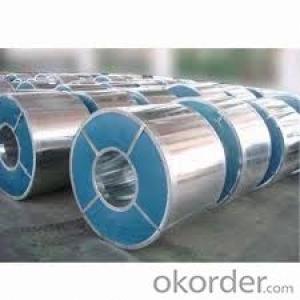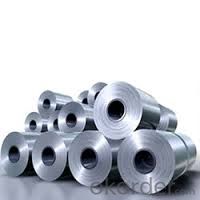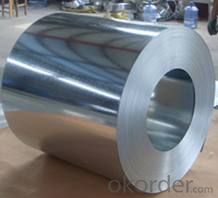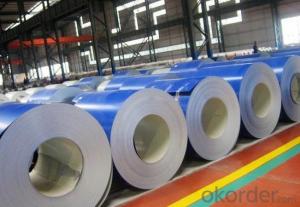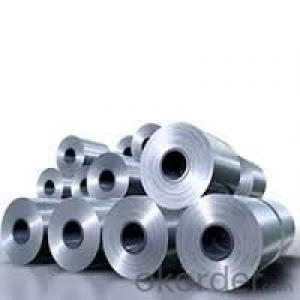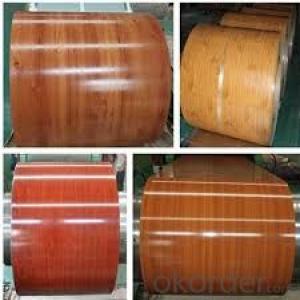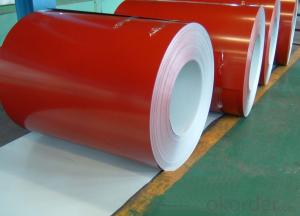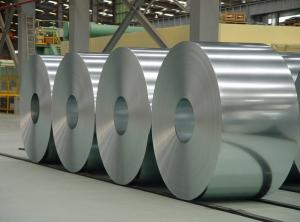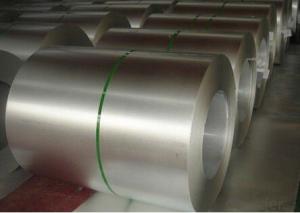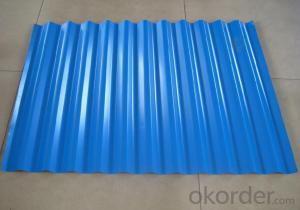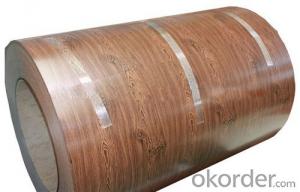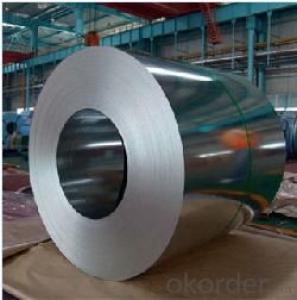Steel Coil Price New Products Hot Dipped Galvanized
- Loading Port:
- Shanghai
- Payment Terms:
- TT OR LC
- Min Order Qty:
- 50 m.t.
- Supply Capability:
- 60000 m.t./month
OKorder Service Pledge
OKorder Financial Service
You Might Also Like
| Place of Origin: | Hebei China (Mainland) | Brand Name: | CNBM | Model Number: | pre-painted galvanized steel coil |
| Type: | Steel Coil | Technique: | Hot Rolled | Surface Treatment: | Galvanized |
| Application: | Container Plate | Special Use: | High-strength Steel Plate | Width: | from 914mm to 1250mm |
| Length: | 1000-2000m | Certification:: | ISO9000 |
Packaging & Delivery
| Packaging Detail: | seaworthy packing or as your requirement |
| Delivery Detail: | 20-45 days after receive down payment. |
Specifications
1.Thickness: 0.15mm-1.5mm
2.Width:914mm-1250mm
3. z40-z275g/m2
4. color: all Ral
CNBM INTERNATIONAL
CNBM International Corporation (CNBM International) is the most important trading platform of
CNBM Group Corporation, a state-owned company under the direct supervision of State-owned Assets
Supervision and Administration Commission of the State Council.
As of the end of 2012, CNBM’s total assets exceeded RMB 300 billion, with more than 150,000
employees, and 20 companies under direct management with 100% share control or majority control,
among which 6 were listed companies, including 2 overseas listed. CNBM ranked NO.319 in the Top
Fortune World 500 of 2013 with 34.46 billion dollars revenue.
For now, we have established strategic partnerships with hundreds of domestic manufacturers and
extensive business relations with clients from over 120 countries in the fields of building materials and
equipments by making full use of its absolute superiority in both abundant source and solid technology
support. Currently, we have wholly-owned overseas subsidiaries and branches in 5 countries with a view
to realize localization, which also represents an essential progress in our globalization target.
STEEL SHEET/COIL DEPARTMENT
Our department is specialized in manufacturing and exporting the following products.
HOT ROLLED STEEL
COLD ROLLED STEEL
HOT-DIP GALVANIZED/ALUZINC STEEL
PRE-PAINTED GALVANIZED/ALUZINC STEEL
PRINTING STEEL
We can ensure that stable quality standards are maintained, strictly meeting both market
requirements and customers’ expectations. Our products enjoy an excellent reputation and have been
exported to Europe, South-America, the Middle-East, Southeast-Asia, Africa and Russia etc.. We sincerely
hope to establish good and long-term business relationship with your esteemed company.
COMPANY
PROFILE
- 1 -
- 2 -
Steel Coil/Sheet
CNBM UAE
CNBM INDIA
CNBM GERMANY
CNBM BRAZIL
CNBM K.S.A
CNBM INDONESIA
CNBM THAILAND
CNBM SOUTH AFRICA
- Q: How are steel coils protected against moisture and humidity?
- Steel coils are protected against moisture and humidity through a variety of methods. One common method is the application of a protective coating on the surface of the steel. This coating acts as a barrier, preventing moisture from coming into direct contact with the steel surface. Coatings can be made of various materials such as paint, zinc, or other corrosion-resistant substances. In addition to coatings, steel coils are often wrapped in a moisture-resistant material such as plastic or waxed paper. This wrapping provides an extra layer of protection, preventing moisture from seeping into the coils during storage or transportation. Furthermore, steel coils are typically stored in a controlled environment with controlled humidity levels. This helps to minimize the chances of moisture condensation on the surface of the coils. Storage facilities may also utilize dehumidifiers or other moisture control measures to maintain optimal conditions. Lastly, proper handling and transportation practices are crucial in ensuring the protection of steel coils against moisture and humidity. Special care is taken to avoid exposing the coils to rain or excessive humidity during loading, unloading, and transportation processes. By employing these various protective measures, steel coils can be effectively safeguarded against moisture and humidity, reducing the risk of corrosion and maintaining their quality and integrity.
- Q: Can steel coils be coated with color-changing materials?
- Yes, steel coils can be coated with color-changing materials. These materials, commonly known as thermochromic or photochromic coatings, can change color based on temperature or exposure to light, respectively. The application of such coatings on steel coils can provide an aesthetically pleasing and dynamic visual effect, making them suitable for various applications like automotive, architectural, and consumer products.
- Q: How are steel coils used in the production of scaffolding?
- Steel coils are used in the production of scaffolding as they are typically cut and shaped into various components such as tubes, frames, and brackets. These coils provide the necessary strength and durability required for scaffolding structures, ensuring the safety and stability of workers who use them.
- Q: What are the different methods of cutting edge trimming for steel coils?
- There are several different methods of cutting edge trimming for steel coils, each with its own advantages and applications. Some of the most commonly used methods include: 1. Shearing: Shearing is a widely used method that involves cutting the edge of the steel coil using a pair of sharp blades. This method is relatively quick and efficient, making it suitable for high-volume production. However, shearing may result in some distortion or burrs along the cut edge. 2. Slitting: Slitting is a process where the steel coil is passed through a set of rotating circular blades that cut the coil into narrower strips. This method is commonly used when precise width control is required, such as in the production of narrow strips or slitting coils into multiple widths. 3. Laser cutting: Laser cutting is a highly precise method that uses a laser beam to cut through the steel coil. This method offers the advantage of producing clean and precise cuts without any distortion or burrs. Laser cutting is often used for complex or intricate shapes that require high accuracy. 4. Plasma cutting: Plasma cutting involves using a jet of ionized gas to cut through the steel coil. This method is particularly suitable for cutting thicker materials or for applications where high cutting speeds are required. Plasma cutting can produce clean and smooth cuts, although the edge may have a slight bevel. 5. Waterjet cutting: Waterjet cutting utilizes a high-pressure jet of water mixed with an abrasive material to cut through the steel coil. This method is highly versatile and can cut through a wide range of materials and thicknesses. Waterjet cutting is known for its ability to produce precise cuts without any heat-affected zone. 6. Sawing: Sawing is a traditional method that involves using a rotating saw blade to cut through the steel coil. This method is commonly used for thicker materials or when a rougher cut is acceptable. Sawing can be performed manually or using automated sawing machines. Each of these methods has its own advantages and considerations, and the choice of method depends on factors such as the required accuracy, production volume, material thickness, and desired edge quality.
- Q: I remember my dad saying something about steel toed boots but I forgot =#92; I went and checked out all the stores and got a pair with good ankle support but they also have steel toes. Would this interfere with the shifter or anything? I figure if anything my dirt bike shoes have the steel toes too. Any opinion?
- I honestly don't like riding with heavy boots on my sport bikes. It it tough to get a feel for where neutral is, and there really isn't a ton of clearance between the peg and the shift lever. I prefer lighter, more flexible boots like my old desert combat boots. They are really well broken in and you can really feel what's going on. When I ride a bike with a heal-toe shift like my old Roadking, it doesn't matter nearly as much. You could probably shift pretty well wearing ski-boots. As long as they give you enough feel for the shift lever, any boots will probably be fine though.
- Q: Can steel coils be used in marine environments?
- Although steel coils can be utilized in marine environments, it is crucial to take necessary precautions to avoid corrosion. Given that steel is susceptible to corrosion when exposed to moisture and saltwater, which are commonly found in marine environments, it is imperative to employ protective measures on the steel coils. One such method is treating them with protective coatings like galvanization or painting to establish a shield between the steel and the corrosive elements. Moreover, regular maintenance and inspections should be conducted to detect any signs of corrosion and promptly address them to prevent further harm. By implementing these measures, steel coils can be effectively employed in marine environments while minimizing the risk of corrosion and ensuring their durability and performance.
- Q: What are the common surface treatments for galvanized steel coils?
- The common surface treatments for galvanized steel coils include passivation, chromate coating, and oiling. Passivation is a process where a thin layer of protective material, such as zinc phosphate or chromate, is applied onto the galvanized steel surface. This layer helps to enhance the corrosion resistance of the steel by providing a barrier against moisture and atmospheric elements. Passivation also improves the adhesion of subsequent coatings or paints that may be applied to the steel. Chromate coating, also known as chromating or chromate conversion coating, involves the application of a thin layer of chromate onto the galvanized steel surface. This coating provides an additional layer of protection against corrosion and improves the appearance of the steel. Chromate coatings can be clear or colored, depending on the desired aesthetic. Oiling is another common surface treatment for galvanized steel coils. This involves the application of a thin layer of oil onto the surface of the steel, which helps to prevent the formation of rust and corrosion during storage and transportation. Oiling also provides temporary protection against moisture and other environmental factors until the steel is further processed or used in its final application. These surface treatments are commonly used to enhance the performance, durability, and appearance of galvanized steel coils, ensuring that they can withstand harsh conditions and maintain their quality over time.
- Q: What are the common thickness tolerances for steel coils?
- The common thickness tolerances for steel coils usually range from +/- 0.001 to +/- 0.005 inches, depending on the specific industry standards and customer requirements.
- Q: What are the common applications of hot-rolled steel coils?
- Hot-rolled steel coils are commonly used in various applications such as construction, automotive manufacturing, pipe and tube manufacturing, shipbuilding, and general engineering purposes. They are particularly suitable for projects that require strong and durable materials, as well as those that involve shaping and forming processes.
- Q: Does steel have a valence number and if so, what is it?
- Steel is a mixture, so it doesn't have any valence number. On the other hand, all of the components of the steel mixture are in their elemental forms, so all the various valences are zero.
Send your message to us
Steel Coil Price New Products Hot Dipped Galvanized
- Loading Port:
- Shanghai
- Payment Terms:
- TT OR LC
- Min Order Qty:
- 50 m.t.
- Supply Capability:
- 60000 m.t./month
OKorder Service Pledge
OKorder Financial Service
Similar products
Hot products
Hot Searches
Related keywords
